February 28, 2007
Nathan (without a title)

Sonorous + Sonanos
Nathan (without a title) is a play by the Danish dramatist Christian Lollike staged by Aarhus Theatre. In Nathan (without a title) the actors are surrounded by an interactive digital scenography created by the Danish scenographer Claus Helbo in collaboration with CAVI. The recent staging of the play takes place in the Cathedral in Aarhus. In the interactive digital scenography, footage shot with a thermal camera is projected onto the vault of the cathedral. The interactive part consists of the actors being able to interact with falling pieces of projected text that are closely connected to the course of action.
The play adresses the ever present question of whether Christians, Jews and Muslims will be able to unite in a peaceful co-existence. Christian Lollike wishes to put tolerance to the test in a religious space, and that is why the performance takes place in the Cathedral in Aarhus.
Nathan (without a title) can be experienced in the Cathedral in Aarhus every Monday, Tuesday and Friday until March 16. Check out the video of Nathan (without a title). [blogged by Lene Mailund on Digital Experience]
Posted by jo at 04:19 PM | Comments (0)
February 06, 2007
Sei Personaggi Part 2
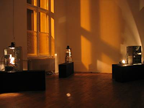
a play in computers
WHERE IS A STAGE CHARACTER IF NOT IN A PLAY? The theatre author Luigi Pirandello holds his fantasy responsible for the six characters visting him, the ‘Sei Personaggi’: father, daughter, mother, son and two little children. An ’operational accident’ as he calls it, as their family drama is not worth it, to be shown on stage. As a start, they discuss their claim with Pirandello himself and later on with the theatre director in Pirandello’s play ‘Six Characters in Search of an Author’. They are playing and explaining themselves to achieve their quest. Their drama is supposed to be turned into a play to concretize them.
Without a play, these figures are ‘alive’ and not existent at the same time. Their scenes are written inside of them and ‘force’ the family to search for a stage and an audience. Their attempt fails in Pirandello’s play, he is leaving them indeterminated.
Sei Personaggi Part 2 by Valentina Vuksic: In the continuation of the 'Sei Personaggi’s' search, the characters are played by computer processes. Reading passages of the manuscripts, the programs mutually control each other according to the signs they are processing. A particular kind of machinic dialogues is being evolved inside the computing systems. Instead of actors, disused hardware affects the course of the play.
Time beating processors and working memories determine time and space of this fictitious, not visible stage, which spreads over the interiors of the networked machines. Microphones follow the fleeting trails of the characters inside the systems’ kernels. [via we-make-money-not-art]
Posted by jo at 12:52 PM | Comments (0)
February 03, 2007
Networked Theatre of the Oppressed

Second Life Theatre Group Meeting
Networked Theatre of the Oppressed :: First informal Second Life theatre group meeting in Bootlab Berlin :: Sunday February 6, noon (brunch time, 12.00 h) :: Tucholskystraate 6.
The dictatorship of the bourgoise melodrama stage has been an inspiration to living theatre, Brecht, Boal, and many. By combining the poetics of storytelling, digital narrative and network performing, the ghostly streets of Second Life become an open stage where the practice of everyday life becomes the raw material for political intervention thru classical drama, literature and net.art techniques. It is time for the triple alienation of the cyburbian multitudes!
Second Life's publicity is generated outside of the internet based on old media PR, circumventing the rest of the net. It is a newbie honeypot, or a themepark for cyberspace history most of all it is a "opera buffa" a theater of vulgarities, and shallow motivations, certainly more reality than what the cultural institution of the theatre has to offer today.
In our first 2 hour practise meeting we want to discuss possibilities of stage design, choreographic moves, myths and topoi, requisites and figurines, sketches of existing 3d datasets and scripting knowledge, we want to identify interesting text resources and invite people researching the field, detecting possibilities for a theater of net.art 2.0 etc. pp. not just revolting but playing with the zombie cybermyths of SL.
The Second Life can not be lived rightly...
- - how can you have virtual sex and no virtual communism?
- - between underworld and purgatory, spaces for the organized networks of
death
- - did 1995 avatar utopia needed lindon economy to reach the masses.
- - there are more than 3 million condemned waiting for liberation.
- - come and sacrifice your pets at a pergamon temple.
- - a virtual world is impossible. lindon dollars are halluzinogenic.
- - california dreaming, do you feel the network effect?
- - zoylent green is us!
- - instalaremos la primera antena zapatista de radio insurgente y la
otra campa??a en second life.
http://bootlab.org
http://possibleworlds.org
Posted by jo at 11:29 AM | Comments (0)
August 04, 2006
Tablescape Plus
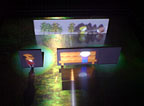
Upstanding Tiny Displays
Tablescape Plus: Upstanding Tiny Displays on Tabletop Displays by Yasuaki Kakehi, Makoto Iida, and Takeshi Naemura, The University of Tokyo :: Emerging Technologies :: SIGGRAPH2006 :: Placing physical objects on a tabletop display is common for intuitive tangible input. The overall goal of our project is to increase the possibility of the interactive physical objects. By utilizing the tabletop objects as projection screens as well as input equipment, we can change the appearance and role of each object easily. To achieve this goal, we propose a novel tablescape display system, "Tabletop Plus." Tabletop Plus can project separate images on the tabletop horizontal screen and on vertically placed objects simlutaneously. No special electronic devices are installed on these objects. Instead, we attached a paper marker underneath these objests for vision-based recogniton. Projected images change according to the angle, position and ID of each placed object. In addition, the displayed images are not occluded by users' hands since all equipment is installed inside the table.
Example application :: Tabletop Theater (pictured above) :: When you put a tiny display on a tabletop miniature park, an animated character appears and moves according to the position and direction of it. In addition, the user can change the actions of the characters by their positional relationships.
Posted by jo at 08:29 AM | Comments (0)
July 25, 2006
Upgrade! Johannesburg: Catherine Henegan
![]()
Dada Goes Digital: Media Art in a Theatrical Space
July 28, 2006 :: Upgrade! Johannesburg and the Wits Digital Soiree present: Catherine Henegan :: Dada Goes digital - Media Art in a Theatrical Space :: Amsterdam-based multi-disciplinary artist, Catherine Henegan, is the director of The Shooting Gallery, the controversial performance / media art work currently showing at The Market Theatre. Aided by a computer and a projection screen, Catherine is also a performer in the work, editing live content from the Internet into the performance by Aryan Kaganof and against the sound design by James Webb. In this way she tracks in real time the way media constructs and reconstructs news and fiction. She will talk about her approach to the design and direction of this challenging multimedia production. More images here.
Posted by jo at 09:26 AM | Comments (0)
July 18, 2006
Human Trials
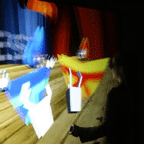
An Absurd Quest
Human Trials -- by Josephine Anstey, Dave Pape, and Sarah Bay-Chengis -- is simultaneously a public / private and embodied / disembodied performance. One user enters an immersive VR and is led on an absurd quest. The challenges appears to be about control and the choices one makes with power; but the games are rigged, the characters are duplicitous, the quest is a decoy, and the underlying test is how to cope with disempowerment. Meanwhile the experience is screened for a voyeuristic audience primed by reality TV. The audience members simultaneously watch multiple viewpoints of the virtual world, while live performers, networked into the VE, attempt to entangle the protagonist in their improvisational machinations.
The performers play two characters, Patofil and Filopat, who engage the participant in a set of overt challenges involving computer-controlled characters and dynamic virtual sets. Beyond these obvious tasks, the participant must also interpret and negotiate a subtext about world views, relationships and alliances. The participant's reactions are logged, interpreted psychologically, and affect the characters' behavior, the presentation of further challenges, and the ending. Although we expect the story to follow a basic arc based on a storyboard, our script/improvisation notes for the actors are evolving during performances.

Human Trials is designed for CAVE or CAVE-like, tracked, immersive VR systems. 3-D stereo displays with one large screen or multiple screens and/or HMDs. Ideally the participant and two human actors each enter the virtual environment from their own VR system. In effect the actors are manipulating life-size puppets since their tracking systems animate the avatars of Filopat and Patofil that the participant sees. A fall-back position is to have the actors operate their puppets from monitors without tracking systems, in this case they can still navigate their puppet wherever they need in the virtual environment.
Human Trials builds on Josephine Anstey and Dave Pape's previous experience building dramatic VR, The Thing Growing, and Networked VR projects, and Sarah Bay-Cheng's experience with drama and puppetry. Human Trials is a sister project to The Trail The Trial, experimental research focused on building intelligent agents to take the place of the human actors.
Posted by jo at 08:33 AM | Comments (0)
December 02, 2005
The Lunatics

Audience Animation
The Lunatics is an interactive experience that guides you through the Lunatics tribe’s transformative journey from being consumers to becoming creators. The Lunatics have always worshiped the moon, but during more precarious times, they ignored it in favour of a more consuming light. They wanted more, more, more; and their cherished moon slipped away. One day, a Lunatic realized that living without the moon was no way to be and set off, with you by his side, to bring it back.
This 6.5 minute animated fairytale is presented using a new form of participatory theater, which blends the role of audience and participant. While wearing masks, you are transported onto the screen and into the story where you see, hear and physically engage with the tale’s themes. Your outlines are projected onto a movie screen and your movements trigger animations that affect the world on the screen. Images and Video.
Canadian Film Centre's Habitat New Media Lab Alumni, Warren Brown, Louise Charlebois, Kirstin Hargie and composer Adam Goddard are set to install The Lunatics at the Emmersive Gallery in Toronto; exhibiting from December 1 to 11. [blogged by Regine on we-make-money-not-artt]
Posted by jo at 08:38 AM | Comments (0)
October 31, 2005
sisterO mauro-flude

All Of Us (girls) Have Been Dead For So Long...
A girl pays homage to damned but beautiful women with bad habits & links these to myths having survived in sagas & fairy tales. She undertakes a journey into the land of the dead in order to become free. She loves the land of the dead. It has as a kind of opiate oblivion beauty, but she resists death. She refuses death on behalf of all the dead girls and also rages at the emptiness of life. Surviving in life despite its inadequacies and infuriating restrictions. She has returned with a powerful force, back into the land of the living. Survives as a fugitive, eluding the authorities that would attempt to transform her into death again.
Wednesday Nov. 16: premiere at 20h30; Thursday Nov. 17: performance ar 20h30; Melkweg Theatre, Lijnbaansgracht 234A, Amsterdam; Reservations: 020 531 8181. Price: 8/7euros. Related website; Images.
Concept/Performance/A/V: Nancy Mauro-Flude
Text: Kathy Acker - extracts from Novel 'Pussy King of the Pirates'
Sound: Lisa Gerrad, Golden Retriever, curseovdialect, The Gits
Dramaturgical Advice: Edit Kaldor
Choreographic Advice: Rose Akras
Technical & Artistic Support: Duro Toomato, Linda Dement, Kristina Anderson, Fiona Tan.
Production Manager: Alexander Godschalk
Thankyou: Theatre Platform Pick Up, DasArts, Pete Zwart Media
Posted by jo at 10:47 AM | Comments (0)
October 20, 2005
Franck Ancel

From Scenography to Planetary Network
From Scenography to Planetary Network [SPN]: an entity of creations, publications, conferences, installations and performances presented by Franck Ancel, in question over contemporary time: the last creation of 2005, in real time via wireless web, via satellite, at an altitude of 30000 feet, more than 900 kilometers per hour, to Tokyo or Shanghai, in the year celebrating France in China and the exhibition of Aichi in Japan.
In the continuation of his triptych AIT in France "Architecture - Image - Technology", these communications prepare for further rendez-vous. Ancel now inhabits the planetary space of technology to fall into and under the reality of the imaginary; a World Fair or a World Tour... like the Solarimpulse plane or like the city of Shanghai between the now and 2010.
Running the planet!: Europa - Amsterdam 09.24.05; America - Banff 09.30.05; Africa - coming soon; Oceania - Sydney 12.02.05; Asia - to Tokyo or Shanghai - End of 2005.
Scenography to Planetary Network for Urban Screens
"If the modern extension of cities is being transformed into urban territory due to the impetus of science-technology, then the classic places of artistic performance remain essentially victims of these changes without really being able to incorporate them.
These new technologies are responsible for the emergence of a “City of Bits”. This “City of Bits” that was analysed as “Space, Place, and the Infobahn” only ten years ago by the researcher William J. Mitchell of MIT in his work of the same name. This was the period of the democratisation of the internet, followed by the appearance of VRML, a time in which some believed that this cyberspace was another world, a new continent, or even, for others, a utopia. Its rise was signalled by the use of a global language, the invention of HTML by a scientist from CERN in Switzerland, which allowed us to move from one computer screen to another without any knowledge of the Internet code.
Thus our project “Being = Network” makes its mark in a city by symbolically confronting the arrival of what the internet scholar Howard Rheingold calls the “smart mobs”. I will rapidly summarize this, like the arrival of the third-generation telephone in Europe. It is this journey between the present and the virtual that I am referring to here all too briefly, that determines the time and reasons for my project, at first glance a simple confrontation of art with architecture, at the moment of the emergence of digital screens in the city.
This “Being = Network” action is not an anticipatory step, but rather a phenomenon which closes without being an end in itself the installation of our AIT triptych in France during the past three years, focusing on Architecture, Image, and Technology. A multiple creation which is not linked to the types of city projection of a Rafael Lozano-Hemmer, a Krzysztof Wodiczko, or a Dan Graham.
Without being a designer, artist, or computer scientist, I do not wish to give a too highly specialized talk, in this city of Amsterdam, birthplace of Constant, founder of the Situationist Movement. However, I am convinced that the visual arts now come from places intended to show them in order to deal with life, and vice versa. This is what propels our search outside of art, architecture, and visual arts. The closest concept is a display to be found at the Scenography to Planetary Network.
Let us call to mind the definition of modern scenography given by its founder Jacques Polieri: “all the pictorial, plastic, technical, and theoretical elements that allow the creation of an image, of a bi- or tri-dimensional set piece, or the installation of an action that is spectacular.” Let us now present the context of this “Being = Network” project that is so decisive in our process. This project of the projection on a screen took place in the centre of Paris in a square, which is situated in a locality that has many cinemas, as well as a stream of people via the metro or the train punctuating the streets.
At the middle, the Montparnasse Tower, a hundred metres from the Gare Montparnasse, at the heart of the city, signals its luminous presence in Paris by night and day. Built at the beginning of the 1970s by the architect Roger Saubot, it imposes by its height of more than 200 metres. There are over fifty floors of offices, each of more than 2000 square metres, with a panoramic restaurant for tourists. This is a Montparnasse that has nothing more in common with the international artistic bohemian life of the 1930s, with its artists’ studios and bars.

(1) Van Wagner, a world-leading communications company recently installed in France, was one of the first businesses to use large advertising spaces, with still projection, in New York during the 1970s. It now owns the screen at the bottom of the Montparnasse Tower, the only one of its kind in France. But it also has the other two screens in the world, one in London and the other in Los Angeles. This LED screen has a surface area of 38 square metres. Obviously, its location in the French capital, at the crossroads of many different types of networks, is what motivated us to spend more than six months negotiating a partnership with the Van Wagner company, with the aim of completing the project free of charge with their technical support.
Several contacts were naturally made with other businesses linked to the networks, such as RATP, the company that manages the Parisian metro system. This was in the hope of using live images from their CCTV cameras for our screen display. Also, with mobile phone companies, because I propose the appearance of cyber-traceability of mobile telephone chips thanks to software monitoring all movement within the city through cartographic superimposition.
This leads to the possibility for everyone to send live photographic and video captures from a mobile phone using MMS onto each window of the screen display. But none of this contact with these companies led to any results, either positive or negative, though the dialogue remains open for other projects. For the moment, I am not directly dealing with questions about the danger of the mobile phone waves for humans, nor about civil liberties’ with regard to CCTV.
Finally Van Wagner did not allow us to use the screen in real time. We did not therefore have access to the MP4 server broadcasting to the screen and potentially via the network to the two other screens, as I would have liked, to produce a live triptych between Paris-London-Los Angeles. In the end, the entire financing of the project came from a private source, as cultural institutions did not help this scheme.
Unlike the first two parts of the triptych, we were not consequently able to use the software in real time; we use MAX/MSP and JITTER. I came up with a global slogan which would be relevant for this specific context. A proposition of a highly prized poetic “hot spot” within the city which only contained the three words “Mobile Wireless Digital” invoked more than interactivity. The monumental projection at the bottom of the tower lasted for thirty seconds, inserted between other advertising clips, several times a minute for several weeks, until the end of December of last year.
Some video captures were selected from the first triptych projects, three for the Convent project built by Le Courbusier and Xenakis, and three from the Franco-Spanish border. These form windows whose size also has meaning. Each window of these short videos is similar to the typical holiday video captured by a mobile phone. The projection is thus made up of a video-wall corresponding to the windows of the front face of the tower. The video clips are thirty seconds in length, corresponding to the length of the advertising clips; but this is also the maximum time for sending this same video via a mobile phone file format, such as the 3GP, via MMS from one phone to another phone.
Here, whether it is appearing on my own mobile phone as a small image, or on the tower as a large one, there is a fictional connection. Without an audience, since no sign, other than newspapers and radio reporting this action, tells us that we are in front of a work and not of prospective products and/or services. If we were in Asia, the formats would be different but our comments would stay the same.
There are different technical supports depending on the continents. The history of media arts has a more universal history, founded on a re-reading and not only a French philosophical reading, with Deleuze, Virilio, or Baudrillard about the arrival of technology. Moreover, I will speak about these issues next week in Canada in a paper entitled “from Scenography to Planetary Network for refresh 01”, which is also the name of the gathering.
There is also a historical filiation for “Being = Network” with a scenography by Jacques Polieri. From the end of the Second World War, Polieri carried out research on historical avant-garde moments in the visual arts, namely those of exactly eighty years ago this year: the Bauhaus with Schlemmer, Gropius, Moholy-Nagy, Molnar, Weininger, the Paris international exhibition with Kiesler and Prampolini, etc. Polieri never stopped from going into and then beyond projects that were too limited by available resources.
Let us think, for example, of his synopsis using exterior screens at the 1972 Munich Olympic Games. Polieri tries to interconnect between them on a micro-scale: “Electronic images were installed from one end to the other of a “Leisure Street”, in the form of either colour VDUs (all along the street) of projections onto large screens permitting the public to dialogue or to participate in the various games. The five main screens were at the end of the street, together with the video control room situated inside a geodesic dome. Preparatory show.” The electronic gave it telepresence dimensions.
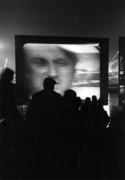
(2) In the meetings that I propose such as “Being = Network”, there can not be an area and a centre which will gain the upper hand, and the same goes for a discipline over a technique. Nor does the image in action simply constitute a performance. It embodies data which can be sound, gestures, an archive, a camera, infinite sources, thanks to digitization: a visualization whose screen is momentarily a performing technical support.
Also, the very existence of this screen in the Parisian space can not be the only grounds for our use of it. It is the context which is virtually projected. It would have been much simpler in a more formal dimension to project somewhere else with total freedom. But I do not want to move the white cube from the gallery, to open a new programme to an audience of contemporary artists, like at the crossroads of Time Square in New York at the beginning of the 1990s.
I am thinking more of an incarnation which, from now on, must no longer just remain within the context reserved for a projection, for it’s not just a projection, but rather of digital data, of finding future areas, like space that is now temporal, for the live broadcasting and recording of our lives. In this way, architecture is no longer the interface for a surface image for our projects, but is valid within a context of watching over emerging issues.
Like the support screens, the urban economy is not the framework of our practice. I am simply looking to determine and be part of the changes that are happening. Using an art without artistic limits, I am not engaging in experimentation but rather in a new way forward, one of widespread interconnection in daily life. So, for each of my designs, a desire to exchange with the professional best is a necessity.
This starts with choosing the site according to the project’s needs as much the same way as its technological items, which is not directly linked to the design or programming. Similarly, the media are no longer mailboxes with images to be re-conceived and re-designed, but are prostheses that are now integrated into our activity and lives.
For example, in our “Global Poetic System” project, which was part of a marathon, we diverted the sporting use of technology towards a digital visual and sound dimension, reconstructable using physical data. I will bring up this necessary conception of new interfaces for these emerging practices in the beginning of December, in a lecture entitled “from Scenography to Network Planetary for e-performance and plug-ins” at the School of Media, Film & Theatre, University of New South Wales, Australia.
To close this “Being = Network”, I would like to share the following anecdote from Bruce Sterling and Richard Kadrey, which is taken from “Dead Media Manifesto”, and which may be found on the Amsterdam internet site “De Balie”. They report the words of Jacqueline Goddarda, a surrealist bohemian figure of 1930s Paris:
“After a day of work, the artists wanted to get away from their studios, and get away from what they were creating. They all met in cafes to argue about this and that, to discuss their work, politics and philosophy… We went to the bar of La Coupole. Bob, the barman, was a terribly nice chap… As there was no telephone in those days everybody used to leave him messages. At the Dome we also had a little place behind the door for messages. The telephone was the death of Montparnasse.”
Our project for third-generation telephones is not necessarily the rebirth of Montparnasse. “You are not the network!” if the projection on the urban screen is your only interrogation. “I am the network!” if you redefine everything with new technology - not only as an urban accessory, but also in the universality of human beings in their future mobile interconnection with the world. While I wait, I am seeking new sensitive places like the Montparnasse Tower in Paris in order to transcribe a new temporality which is now becoming a planetary one." Franck Ancel
(1) Illustration no. 1 “Being = Network”, Paris Montparnasse Tower, photo by Simon Procter, 2004.
(2) Illustration no. 2 “Leisure Street”, Munich Olympic Games, 1972, pp. 42/44/45 “Polieri creator of modern scenography”, Bibliothèque nationale de France, Paris, 2002.
"SPN for urbanscreens05" in Europa and "SPN for refresh!01" in America, these english presentations are now online pdf.
Biography: Born in 1970, France, Franck Ancel works in Paris. He has been probing technology for more than fifteen years. He has traced the development from the avant-gardes artists of the last century to the recent mutations of creation on a planetary scale.He has thus organized and coordinated symposiums, expositions, and performances in cooperation with associations and institutions. The last one was a retrospective on Jacques Polieri, the creator of ”modern scenography,” at the BnF. Since the attacks of 9/11, Franck Ancel has set up an interactive triptych probing “architecture – image – technology” on 20th century heritage sites. In 2002, he put it in the Le Corbusier/Xenakis convent; in 2003 in a classified theater in Catalogne; and in 2004 on the screen of Montparnasse Tower in Paris. Franck Ancel challenges the viewer outside traditional frontiers, by projecting a setting of a network of information on screens. At the same time, he analyzes this technique on a more theoretical level in texts and talk.
Posted by jo at 12:19 PM | Comments (0)
September 30, 2005
Mapping New Territories

LOL (laughing out loud)
LOL: On jan 12th 2003, in Phoenix (USA), a 21-year old computer addict (called hereafter by his nickname "ripper") died of an overdosis of prescription drugs while chatting on the internet. Soon after this tragic event, a text file containing a transcription of the dialogs that occured in the chatroom appeared on numerous websites. Re-processing the dialogs recorded before, during and after his death, the N3KROZOFT MORD multimedia group expands the network tragedy into a caustic ectoplasmic seance.
"...N3krozoft Mord, a collective of media artists based in Geneva, have used the chat log as the script for a re-enactive performance. "The idea was to run this through again, like the film that runs before your eyes just before you die." The title LOL – the online acronym for "laughing out loud" – takes the chat’s commonest statement and uses it to describe the reactions of the participants as they sway between cynicism and helplessness..."
From the Mapping New Territories we site:
PERFORMANCE: 12.03.05, 19:00
The Fatal Failure of Telecommunications
LOL – a performance by N3krozoft Mord
[02:03:40]
[02:03:46]
[02:03:51]
These are the opening lines of an internet chat on 12 January 2003. Ripper is the code name of 21-year-old Brandon Vedas, who was to die at his home in Phoenix that night after taking a cocktail of prescription drugs while chatting with online acquaintances who were watching him on webcam. This tragic incident made the daily papers all over the world and within days, several websites had posted a chat log.
N3krozoft Mord, a collective of media artists based in Geneva, have used the chat log as the script for a re-enactive performance. "The idea was to run this through again, like the film that runs before your eyes just before you die." The title LOL – the online acronym for "laughing out loud" – takes the chat’s commonest statement and uses it to describe the reactions of the participants as they sway between cynicism and helplessness. Actor Nicolas Goulart plays Ripper, going through the actions that can be deduced from the text: Ripper sits, seems restless, drinks, smokes. He swallows pills. He broadcasts himself on webcam and, above all, he types intermittently at the keyboard. The actor replaces the original webcam footage, which was not recorded, and at the same time is the fictitious embodiment that recalls the lost presence of the dead man.
All the while, the chat log is screened in real time like film credits rolling: for 80 harrowing minutes the time code of the dialogue determines our sense of time. Life Images from a webcam focused on the actor are also screened. The authors of N3krozoft Mord intervene subtly in this sober yet obsessive repetition of the event. The footage of a second, moving camera is manipulated in situ as though mirroring the dying man’s drug-fuelled mental state. A troubling live sound track of booming sub-bass and high-frequency dissonance by the musician, 10111.org, underpins the moving image. The grim setting of Ripper’s desk, covered in equipment, paper, ashtrays, pizza boxes and glasses, is adapted from the opening scene of the film Matrix.
N3krozoft Mord’s manipulation of sound and image has a subliminal impact. It heightens the hypnotic magnetism of the authentic text, creating a mental space that acts as a resonator. Soon we find ourselves reacting as the participants did in the chat of January 2003, watching the bright green text unfold on the darkness of the screen, so mesmerised that we forget the reality unfolding in the room.
The virtual room in which Ripper and others are chatting is mainly about the abuse of prescription drugs. Press researchers have put the average age of the participants at 16. Ripper lists the drugs and the amounts and invites the others to watch him on webcam. Within 4 minutes and 9 seconds Phalaris has posted the cynical diagnosis: "attempted suicide # 84". At first, Ripper is egged on: "You pussy, you pussy, eat more." He takes it as a challenge, and boasts about his drug consumption and sexual exploits: "this is usual weekend behaviour, I told u fucks, u all said I was lying." Once it becomes clear that he is heading for a lethal overdose, some of them try to reason with him. Smoke2k writes: "look dude fucking cram it up your ass ... thats crazy ya know ... don't eat it... your already numb." Others send urgent virtual cries: "riipper ... RIPPER :((((" They even discuss whether to call the emergency services. But then they have their doubts – maybe Ripper is just acting out a suicide scene. Can the webcam be believed? Oea tries to call his bluff, then tries to coax Ripper back to life with a declaration of love. The medium heightens the kind of inaction that sometimes sets in among witnesses to a road accident. "you will never know if he died unless he get back on here," writes theKat, and grphish replies: "i know ... thats kinda freaky."
Another media-specific factor confuses matters: Pnutbot, who enters the conversation repeatedly at certain keywords, is not a human being capable of decision and action, but an automated chat robot. It remains a moot point whether Ripper himself programmed Pnutbot to throw in the poison control emergency number in a vain attempt to create some security within the casual framework of the chatroom. The kids in the chatroom are smart enough to find out, within seconds, the IP of the server and, with that the actual address of the anonymous Ripper. They have details – the lethal dose, the home address, the fact that his mother is in the room next door killing time with crosswords. But they do not add the bits together to a conclusive or binding narrative. Still less do they manage to translate them into the reality of the outside world and actually intervene.
In the chatroom, the gulf between simultaneous presence and absence offers protection, the liberty of risk-free intimate communication and a sense of belonging. In this serious situation, however, the same gulf becomes an insurmountable barrier. The young people are held back by the question as to what is real about what is happening in the virtual room. Or, to put it another way, what is fictional about the reality of what is happening. And quite a few of them cannot resist the temptation of simply withdrawing from their masked existence with impunity, from a chat that usually leaves only data trails, rarely corpses.
The simultaneity of presence and absence is mirrored in the setting of the performance without moral judgement. The audience is given a glimpse into both rooms, which cannot be brought together – neither in the actual incident nor in the performance. The gap between physical room and chatroom, between body and language, seals Ripper’s fate.
The N3krozoft Mord group, whose name itself combines computer and death, is interested in the subconscious, darker sides of telecommunication: "In the case of this chatroom protocol, what is unique is that the trail of the event itself describes the event. And it is a text that would not exist without the technical tools by which we communicate. It records and witnesses the death of a young man, but at the same time it is a statement about the vehicle of communication. ... The notion of telecommunication has always been linked with death. Even Edison’s phonographs were meant to record the voices of people so that they could still be heard after their deaths." The morbid aspect of telecommunication is also the subject of N3krozoft Mord’s latest audio work. Ubik is based on the sci-fi novel of the same name by Philip K. Dick, which describes how technology is used to retain the consciousness of the dead. With proper treatment, individuals become "half-lifers" and can communicate by voice from this semi-dead state, a kind of technically generated limbo. Fiction infiltrates our experience, whereas in Laughing out Loud, it is exactly the opposite: the fact of death tries in vain to penetrate the surface tension of a virtual community.
[02:55:32]
[02:55:46]
Text: Raffael Dörig und Annina Zimmermann
Credits
LOL – a performance by N3krozoft Mord
Idea & concept: N3krozoft Mord
Video projection, programming, installation: N3krozoft Mord
Audio: 10111.org
With support of: Bundesamt für Kultur/sitemapping.ch
www.n3krozoft.com
www.10111.org
Posted by jo at 09:47 AM | Comments (0)
August 07, 2005
m@terials:
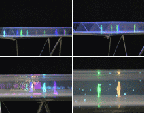
3D Theater on a Table
m@terials, developed by Jitsuro Mase, use an off-the-shelf LCD projector to display a "3D theater" on a table. A video clip available on the Digital Stadium website. It's amazing that this actually works because the hardware device looks deceptively simple. On the table top are transparent plastic strips standing diagonally at 45 degrees. The plastic strips make images stand up. The virtual people can be projected on to a strip closer to you or the ones further away from you.
Digital contents that can be effectively displayed on this device should conform to specific rules, however, "it is not so difficult" according to the creator of this device. This device could be used for many different kinds of things besides the "3D theater" especially if it could be made larger (possibly as big as a computer displays or a building floor?) with hi-fidelity realistic images. [blogged by manekineko on we-make-money-not]
Posted by jo at 07:05 AM | Comments (0)
July 06, 2005
Façade + Auto Mata

Finally, the Curtain Opens on Façade
This long-awaited one-act interactive drama, featuring a 3D environment and voice-acted, AI-driven characters, Façade has been a testbed for research in and development of new discourse-based NLP techniques, a new drama management framework, and new ways of allowing behavior hierarchies to interact. It has been the source of more than a dozen academic publications co-authored by Michael and Andrew, as well as Michael’s Carnegie Mellon University Ph.D. dissertation. A pre-release version of Façade was a finalist in the 2004 Independent Games Festival. Façade is also delightfully entertaining and abundant in its dramatic and artistic merits. It offers a fairly short dramatic experience that is intensive and compelling, and unlike anything else I have seen in video games or other interactive systems.
The New York Times called Façade “the future of video games” and one person who has devoted his life to interactive storytelling, Chris Crawford, said the system was “the best actual working interactive storyworld yet created.” You can read the official press release on Façade, read on for more about the release, or skip directly to the download page on InteractiveStory.net.
From there, you can download the 800MB program via BitTorrent; Andrew and Michael also provide the program on two CDs which are sold at cost, for $14 plus shipping.
Since the program is provided for free and and the CDs set is sold at cost, and because you like schwag, you may also be interested in supporting the creators of this system by purchasing some of the Façade merchandise that is available. The items for sale include the “hint book” Behind the Façade, which Andrew and Michael will email for a donation of only $5; there are also T-shirts, a hat, and other items.
Although we love for you to post comments here, and hope that you will, there will also be a bulletin board set up on InteractiveStory.net for detailed discussions of matters related to Facade. I can’t wait to hear what others think of this piece. Michael and Andrew tell me that they are also eagerly looking forward to people’s feedback about, comments on, and criticism of the first fully-realized prototype interactive drama, Façade. [blogged by Nick on Grand Text Auto]
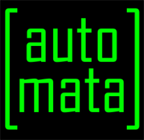
Auto Mata: A New Label for Computer Lit, Art, and Games
Auto Mata, an independent label for extraordinary e-lit, digital art, and computer games, has just been launched by the six “drivers” of the blog Grand Text Auto: Mary Flanagan, Michael Mateas, Nick Montfort, Scott Rettberg, Andrew Stern, and Noah Wardrip-Fruin.
Façade, the long-awaited one-act interactive drama by Michael Mateas and Andrew Stern, is the first Auto Mata release. The interactive fiction Book and Volume is in the works now and will be coming from Auto Mata soon. [via elo blog]
Posted by jo at 12:22 PM | Comments (0)
July 01, 2005
John "J.Walt" Adamczyk
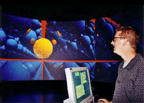
Live Animation Performances
Graphic performances are animated paintings and sequences created live in real time. John "J.Walt" Adamczyk utilizes the latest in interactive computer graphics techniques to bring paintings to life. The result is a Spontaneous Fantasia, a visual music that unfolds before an audience. These works incorporate elements of animation, theater, dance, painting, sculpture, music, architecture, and interactive art.
With my graphic performances, I take literally the meaning of the word "animation": making images come to life. I use my drawing skills to give directions to computer programs I've written. I aim to capture the sensitivity of gesture, but I also use techniques which amplify and augment the gestures. The wave of the arm or the stroke of the pen is still there, but the effect is much more. My creative process for these pieces is to continually shift between painting, programming, composing music, and performing. I practice each piece until I am satisfied that I can perform with ease. At that point, the computer interfaces and the program are like a musical instrument.
Posted by jo at 08:37 AM | Comments (0)
June 17, 2005
Internet Theatre Fest
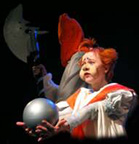
Cross-Cultural Artistic Expression
Last October, Moscow’s Interstudio presented the First Interactive Theatre Festival. Seven Russian companies – performing in four locations and a variety of theatrical traditions – participated in this groundbreaking event. Productions were streamed live from Moscow, Perm, St. Petersburg, and Komsomolsk-na-Amure to the Interstudio site, and viewed by over 2000 users from more than fifty countries.
Featured in the festival were: Pyotr Fomenko Atelier (Moscow) performing THE FAMILY BLISS, The Shadow Theatre (Moscow) performing MISANTHROPE / RAIN AFTER THE FLOOD, Elena Kamburova Music and Poetry Theatre (Moscow) performing P. S. REVERIES..., Evgeny Panfilov Ballet (Perm) performing EIGHT RUSSIAN SONGS / BOLERO, Helicon Opera (Moscow) performing LULU, KnAM Theatre (Komsomolsk-na-Amure) performing REINSTATEMENT OF DADAISM, and The Comic Trust (St. Petersburg) performing THE WHITE SIDE STORY.
Following the final production of WHITE SIDE STORY, audience members from Moscow, St. Petersburg, and New York participated in a discussion forum conducted via web conference. Participants shared their visions for cross-cultural artistic expression, and their hopes for future streamed performance festivals. Though this fledgling effort weathered many technical difficulties, viewers voiced enthusiastic agreement about its tremendous potential.
The festival organizers had tried to anticipate bandwidth problems by asking viewers to register in advance, but on the first day of the festival, the website was swamped, and finally overwhelmed by high demand.
Viewers were offered a choice of three video streams, one with sound, which could also be viewed simultaneously. Audience members in New York, watching a wall-sized projected image, had a detailed view of the performances, although some viewers were distracted by the lack of synchronicity between the three video streams. Some audience members also expressed their desire for a view of the live audience, and a look at the theater space – two things that might have helped them get a feel for the live performance experience.
At the same time, New York viewers were excited by the unique opportunity to experience an unfamiliar theatrical style. Most felt they understood the Russian shows -in spite of the language barrier and technological limitations - and talked about how the Russian work could influence their own artistic work.
The Russian performers also seemed excited by the new possibilities explored in the festival. One company – from a small Russian town – had never dreamed they would be able to reach such a large international audience. Directors and performers had many ideas about ways to improve the web-streamed experience, including rehearsing camera operators and designing staging for the camera as well as the live audience.
Theatre-Web hopes to put these ideas into practice in future festivals. [via Digital Performance]
Posted by jo at 08:16 AM | Comments (0)
June 08, 2005
La Fura Dels Baus
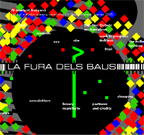
DIGITAL THEATER
Digital theater is the addition of actors and 0 and 1 bits, moving in the net. Actors in digital theater may interact from different times and places… The actions of two actors in two different times and places coincide in the network of infinite times and virtual spaces. On the 21st century, genetist conception of theater (from the generation to the birth of the scene) will be replaced by an organization of interactive and intercultural activities.
Digital theater refers to a binary language connecting the organic with the inorganic, the material with the virtual, the actor in the flesh with the avatar, the present audience with the internet users, the physical stage with the cyberspace.
The digital theater of La Fura dels Baus allows interaction on stages inside and outside the net, inventing new hypermedia interfaces. Hypertext and its protocols create a new kind of narration, closer to thoughts or dreams, generating an inner theater where dreams become (virtual) reality.
Internet is the realization of a collective thought, organic and chaotic, that has been developed with no defined hierarchy. Digital theater multiplies in thousands of representations where cybertheater fans may display images of their own subjectivity, within shared virtual worlds.
Will digital theater perpetuate Phallocracy? Will Vaginocracy eventually win? Or will both join in perfect harmony 0-1?
In digital theater, the absolute abstraction coexists with the return to the body, that may have a sadomasochist dimension —as well as a sensual, angelical, or orgiastic dimension; or perhaps a mixture of all of them.
By definition, theatrical act involves an excess, a surplus of performance. It’s the pleasure of showing and being shown. An identification flow is established between the actor and the audience. How does this identification work in digital theater? How does a hand fit into a glove? As an extension of oneself? With the integration in the net?
Digital technology makes the old dream of transcending the human body possible. Thus, cyberspace may be inhabited by bodies with a new representational envelope, between subjectivity and materiality.
We have to leave our own skin to penetrate into a common perceptual reference. The roles of the actor, the author and the audience tend to merge.
Digital culture does not belong to a reproduction technology anymore, but to an immediate production. While photography spoke in the past “it was like this”, by freezing an instant, digital image speaks in the present “it is like this”, joining the live act, the theater, the here and now.
Digital theater allows the image to mutate, from one configuration to another, actual and virtual, placing it in different stages: an icon of synthesis which will always remain HUMAN. [via]
Posted by jo at 02:12 PM | Comments (0)
January 24, 2005
ASL [v.f.] 1.0

Age, Sex and Location
ASV [v.f.] 1.0 was the first version of the "chatroom plays"--by Vincent Makowski/AmsterdamEditions--performed during the Internet Fiesta and the Irish Museum of Modern Art's Net.art exhibition on March 23rd, 2002.
"The chatroom plays just slightly twist the original purpose of chatrooms. With ASV [v.f.] 1.0 (which in English should rather be ASL for Age, Sex and Location, the most basic self definition given by chatters to those they interact with), I intended to use a chatroom as a theater stage and asked professional actors along with some people having no acting experience to play a role we defined together...(N)one of the actors' cues were pre-written and we had no rehearsal whatsoever. Furthermore, we never met before and (or) during the performance. Our communication only went through e-mails exchanged between the actors and myself.
They were asked to define their own role and we built their character and personality together through e-mail exchanges from then on. No plot was defined prior to the performance: I was not interested in creating a linear fiction but rather a real time remote interaction between the actors. I wanted to push live performers (professional actors) to experiment the sole use of written words, in opposition to their actual physical presence on a stage. The chatroom plays allow me to raise the question of live performance on the internet. The time necessary to type the cues (which varied from one actor to another depending on how fast they could type) generated delays in the answers to specific cues. This succession of unrelated cues could be read as something close to the "cadavre exquis" developed by the surrealists. Even though data was instantly transmitted simultaneously to all the actors' computer screens, the keyboard operating introduced a stretch, a delay preventing real time exchanges to be experienced. This paradoxical man/machine ability and time was, more than the meaning of the cues themselves, at the center of this work."
Posted by jo at 02:57 PM | Comments (0)
January 07, 2005
LifeLine
""...Traditionally, the performing arts is comprised of three components - the performer, the audience, the stage. The performer engages the attention of the audience; the audience observes and responds to the gesture and prose articulated by the performer; the stage provides a formal structure within which the relationship between performer and audience is cultivated and sustained. Separation from the creative process is perpetuated whilst the stage imposes its own criteria upon it." 1.
The hierarchical performance space described above is posited on notions of authorship, in the modern history of cinema and theatre first the writer, then the text and finally the context have all laid claim the authority of meaning. New forms of performance especially interactive forms rely on a more democratic distribution of authorship that occurs when the performance space no longer relies on the separation of author and audience but engenders an integrated space, a space shared by both the performer and the audience that disperses authority." from The Extended Logic of the Interactive Performance Space by Gregor White.
Posted by jo at 05:29 PM | Comments (0)
December 27, 2004
netzwissenschaft
![]()
Emerging Infrastructures of All (Inter)net Research
Dr. Reinhold Grether's network research | netzwissenschaft site maps the "emerging infrastructures of all (inter)net research endeavours. net.science as an anthropology of connectivity is trying to overcome the constraints of specialist method transfers on net matters. the protuberance of technical networks necessitates a professionalization of human net knowledge. neither the isolation of concepts as in basic research nor the encapsulation of processes as in applied sciences will ever be able to adequately describe the complex autopoiesis of networks. net.science is undoubtedly developing into a scienza nuova of its own right."
Check out his Mobile Art and Virtual Performance research areas.
Posted by jo at 04:45 PM | Comments (0)
October 14, 2004
Liebst du mich Lump

Thoughts run through the net
In Beckett's "Waiting for Godot" nothing happens. Twice. During Beckett's "Liebst Du mich Lump" a lot of things happen. Simultaneously and in different places. The piece adresses the internet-public, only 8 spectators are permitted on location.
"Liebst du mich Lump" takes place in a labyrinthine theatrespace with the walls full of graffiti located in the heart of Berlin-Friedrichshain. But already the delicate, frail nervestream of a Sleeping Beauty in deep sleep, lying in the "skulpturalen Versuchsraum 2" of the "Deutschen Museum" in Munich can change the way the actors act. Thoughts run through the net, also from the internetcafe "Oraniennet" in Berlin- Kreuzberg 36. There, an ironmask is connected with a computer through which users can also manipulate the play with the vibration of their voices. A neuro-virtual "ménage a trois" is being created. Coincidence rules, speech dissolves to a mathematic formula, to oracular words which are put together every evening in a new way.
Opening night: October 19 -November 2, 2004 at 8 pm; Watch the Internetlivestream: www.beckett-pi.de; DSL/Windows.
Posted by jo at 05:15 PM | Comments (0)
September 02, 2004
The Crazy Wisdom Sho

Remote Teleprompting
Unfortunately, there's no video archive on George Coates' web site, which seems to have been abandoned in 2001. However, you can read about The Crazy Wisdom Sho, an experiement in live theater and the Internet in which live performers in a San Francisco Civic Center Theater were onstage surrounded by web-enabled teleprompters. At selected moments, the actors were controlled by online participants who had submitted Crazy Wisdom to the teleprompters via the website.
And, according to George Coates, "(The George Coates Performance Works) produced a show called the "Nowhere Band" that included an inter-actor named Ralph who arrived on-stage via the internet every night at 8:30 PM PST for a five week performance run. This was the first distributed live performance ever to occur as part of a regularly scheduled theater run. Audiences in our theater would see Ralph blow into his pipes to sound a `C' note in Australia establishing the musical key, as the Nowhere Band in San Francisco tuned their instruments to his bagpipe for the first number played in the show. This show premiered at our civic Center theater in San Francisco in 1994." This quote is from "The New Performer" by Sheila A. Malone.
Malone continues: "The idea of space and real are connected with the idea of a time-based experience. The relationship of live characters is absolutely dependent on the interaction with the virtual characters. George Coates takes these ideas of real and hyperreal and completely mesmerizes audiences with the production of "20/20 BLAKE: The Visions Of William Blake." George Coates describes the performance, "at one point we had even hacked a way to make two SGI graphics engines run simultaneous stereographic interactive animation programs enabling audiences wearing polarized glasses to experience stereo 3D illusions of volumetric space interacting in real time with live actors on a stage. (This enabled, for example, a flock of birds to appear to hover over the stage and audiences, swooping down to harass the live actor, chasing the actor around the stage wherever the actor chose to go - in real time)." Here Coates and his company of actors, technicians, and virtual images are merged with the audience into a space created and controlled by the computer and its operators. The definition of performer has changed. But the presence of space and time are consistent common denominators in the performance."
Posted by jo at 06:08 PM | Comments (2)
August 21, 2004
ultra modern - very social
Another Motherboard project, ultra modern - very social is a streaming theatre concept for 2002 and beyond. This space is dedicated to the pursuit of experimental theatre which is somehow modulated and mediated by the intermediary influences of the net, but may also involve communcation appliances such as telephones, mobile phones, walkie-talkies, radio, etc. Our emphasis is on improvisation and experimentation where "here and now" and "there and then" are relative expressions in collaborative networked spaces.
Posted by jo at 11:31 AM | Comments (0)
August 01, 2004
Tele-Actor
Hello all:
I am really amazed by the amount of activity on the blog -- looks like we've hit on a potent topic.
One project I want to add to the mix is Ken Goldberg's Tele-Actor , which is now about two years old. People online vote on what they want an actor to do. That actor is equiped with a wearable computer, including cams, mics, etc.
From the website: "The "Tele-Actor" is a skilled human with cameras and microphones connected to a wireless digital network. Live video and audio are broadcast to participants via the Internet or interactive television. Participants not only view, but interact with each other and with the Tele-Actor by voting on what to do next. Our "Spatial Dynamic Voting" (SDV) interface incorporates group dynamics into a variety of online experiences."
It seems to me that many of the pieces mentioned so far not only are networked or distributed in nature, but also utilize non-linear narratives that have not been been predetermined. Coincidence?
Brooke
Posted by at 10:04 PM | Comments (1)
July 31, 2004
Historically Locating Distributed Performance
2004.04.05 Helen Thorington, writing about an early conference proposal:
The following are examples of distributed performances:
Finding Time (Jesse Gilbert, 2000). Finding Time linked performers on six continents in a series of live musical events, each an hour’s duration.
World Wide Simultaneous Dance (1998, Laura Knott). The project took place simultaneously in twelve countries.
In both examples the performers played to audiences in their performance spaces and to a worldwide Internet audience by means of especially created websites.
I then move on to a brief history, beginning with Kaprow's "Hello Hello" in the mid-60s--about which I can find very little information other than that it linked five sites in a television event. And on to Kit Galloway and Sherri Rabinowitz.
But the history is the not the question for me. Internet works resonate with historical issues. But what I'm beginning to think as I research for the conference is that we may already have witnessed the passing of the (pre)structured presentation of large-scale performance works--I keep thinking, for instance, that while Adrift (1997-2001) was very different from other works produced at its time, it was also very traditional. It was a work by three artists (the senders), in which its audiences had no agency at all--Like radio, like television, they were cast in the role of "receivers."

From the Adrift performance
Now...when did it happen?...the Internet environment is in a far more participatory stage and people-interest runs to works/platforms/
environments in which the former viewer can play an active role. Which may begin to explain why there are really not very many interesting large performance works being produced at this time. Not only is the technology still difficult but the environment is no longer congenial.
Or am I wrong? And if not, what does this do for/to our conference?
I'm going to think about this for awhile. Right now my only thought is that if this is so, the conference itself should reflect it and include the many twists and turns performance has taken in the last years.
Posted by michelle at 01:22 PM | Comments (0)
July 30, 2004
Distributed Cinema
SPEC-FLIC
Described by Adriene Jenick as a "Speculative Distributed Cinema Project....a series of fictional events performed as distributed cinema. SPEC-FLIC is a platform for speculation, creative experimentation and imagination among UCSD students, faculty, staff and the larger public. SPEC-FLIC's title refers to speculative fiction (an area of science fiction that is focused less on new science/tech and more on societal impacts) as well as to the size (a "speck") of the PDA-based video frame that serves as the conduit for this durational collective performance. Originally described as a distributed science fiction soap opera in three phases."
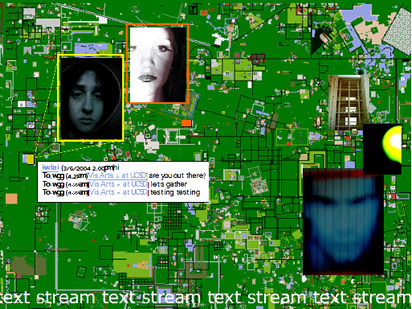
Adriene, tell us about this image.
What is the technology and experience behind this work?
Would you speak about the progression of your work from Paper Tiger television to Desktop Theatre on the internet to Active Campus and Spec Flic on the wireless network?
In your initial post you note these ongoing issues. Can you discuss them by way of examples from your work?
- timing/pacing/duration
this can be thought of from the perspective of participants or from "viewers" - in my experience the "lags" and glitches are all absorbable within the context of a live event. The archiving of this work does not allow for its tension to exist
- relationship of writing to performing, or textuality and orality
this is hugely fascinating to me especially considering the constant evolution of written and spoken language
- use of agitprop to catalyze unexpected engagements
all of my work is engaged within the larger "publc sphere" and cedes a large amount of control to the folks who are engaging with it.
Regarding SPEC-FLIC, your blog shows you in the midst of testing equipment. What are you testing? What is your creative process for working with technology and networks?
Posted by michelle at 09:42 PM | Comments (0)
Networked Local Performances
Three Performances: 2001-03: A Comment
The three location-specific performances Dialtones: A Telesymphony, Flip Flop, and Texterritory --you had to be there to experience them--introduced in the last posts were produced between 2001 and 2003 They made use of networked technologies--mobile phones, video/audio relayed by wireless broadband--to involve their audiences in the creation of the performances. Each has done this successfully in its own way, while maintaining control, in the case of Dialtones, a tight control, over the performance itself.
Posted by newradio at 10:06 AM | Comments (0)
July 29, 2004
Networked Local Performance
Flip Flop
Flip Flop comprises a group of motion poets, cyborgs, and sound, video and net-artists who collaborate on ‘site-specific remote connection theater performances’ that, in their words, "challenge boundaries between audience and performer, on-stage and off-stage, the venue and the street outside."
For instance: the audience is invited to a party where, over the course of the evening, one of the partygoers (actor and motion poet Ajay Naidu) emerges as a performer, and the audience gradually realizes that it is participating in theater. As the performer shifts between private conversation and "narrative outbursts," the event shifts in mood and form.
Simultaneously, a performer, equipped with a wearable multimedia-streaming computer roams the neighbourhood. The route is choreographed to synchronise with the performers story, and a live "point-of-view" video feed (as well as audio) from the wanderer is relayed by wireless broadband to the performance venue. Flip Flop was performed in July, 2002. Read a report on Live Streaming as Dramaturgy.
Posted by newradio at 06:17 PM
